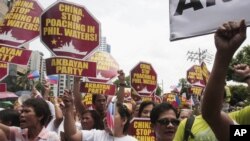Activists opposed to China’s territorial claims in the South China Sea marched on the Chinese embassy in Manila Friday, further escalating the two countries’ territorial dispute.
Huangyan Island is a small, rocky outcrop of land about 220 kilometers from the Philippine mainland of Luzon. Tensions in the region escalated on April 10 when the Philippines accused Chinese vessels of illegally fishing in Philippine territory.
China has long claimed sovereignty over the islands, called the Scarborough Shoal in the Philippines.
On Friday, foreign ministry spokesperson Hong Lei blamed the Philippines for rising tensions between the two countries. He said the Philippines side encouraged people to hold anti-China embassy protests, an action that complicates and magnifies the situation.
Hong said China pays great attention to the safety of Chinese nationals in the Philippines and has demanded the Philippines take effective measures to earnestly protect the safety of Chinese nationals and institutions in the Philippines.
The dispute has become an issue of national pride for some Chinese. Small groups of protesters marched in front of the Philippine embassy in Beijing, Friday.
"I believe this Huayuan Island is an inseparable part of China. I hope their governments don’t make this a cause for bad relations," one protester said.
The protest in Manila was much larger than the one in Beijing. Hundreds of protesters marched in front of the Chinese embassy - many carrying placards that read: “China Back Off.”
“The main objective of the protest action is to call the attention of the international community with regards to the Chinese government’s continuing and escalating intrusions in the Panatag [Scarborough] shoal area which we strongly believe is an integral part of the Philippine territory,” explained Emma Hizon, one of the organizers.
The standoff escalated in April when China sent two maritime surveillance ships to prevent the Philippines from arresting Chinese fishermen off Huangyan Island. A Philippines coast guard vessel is currently facing off with the two Chinese ships.
Several countries claim parts of the South China Sea, including Vietnam, Brunei, Malaysia and Taiwan. The waterway is a strategically important trade route and a potentially rich source of oil and natural gas in the region. But Chinese officials have ramped up warnings in recent weeks about the territorial dispute, with state-backed newspapers warning of “small-scale war” if the Philippines does not back off.
China warned its citizens in the Philippines to be cautious and the China International Travel Service, a large government-run travel agency, said it was postponing trips to the Philippines because of the protests. The standoff is also affecting trade between the two countries. In what may be a punitive action by the Chinese government, 1,200 containers of bananas from the Philippines are being held in customs because of what authorities say are "quarantine concerns".
Meanwhile civic groups in the Philippines say they are planning more protests outside of Chinese missions in New York, Singapore and Rome.
Huangyan Island is a small, rocky outcrop of land about 220 kilometers from the Philippine mainland of Luzon. Tensions in the region escalated on April 10 when the Philippines accused Chinese vessels of illegally fishing in Philippine territory.
China has long claimed sovereignty over the islands, called the Scarborough Shoal in the Philippines.
On Friday, foreign ministry spokesperson Hong Lei blamed the Philippines for rising tensions between the two countries. He said the Philippines side encouraged people to hold anti-China embassy protests, an action that complicates and magnifies the situation.
Hong said China pays great attention to the safety of Chinese nationals in the Philippines and has demanded the Philippines take effective measures to earnestly protect the safety of Chinese nationals and institutions in the Philippines.
The dispute has become an issue of national pride for some Chinese. Small groups of protesters marched in front of the Philippine embassy in Beijing, Friday.
"I believe this Huayuan Island is an inseparable part of China. I hope their governments don’t make this a cause for bad relations," one protester said.
The protest in Manila was much larger than the one in Beijing. Hundreds of protesters marched in front of the Chinese embassy - many carrying placards that read: “China Back Off.”
“The main objective of the protest action is to call the attention of the international community with regards to the Chinese government’s continuing and escalating intrusions in the Panatag [Scarborough] shoal area which we strongly believe is an integral part of the Philippine territory,” explained Emma Hizon, one of the organizers.
The standoff escalated in April when China sent two maritime surveillance ships to prevent the Philippines from arresting Chinese fishermen off Huangyan Island. A Philippines coast guard vessel is currently facing off with the two Chinese ships.
Several countries claim parts of the South China Sea, including Vietnam, Brunei, Malaysia and Taiwan. The waterway is a strategically important trade route and a potentially rich source of oil and natural gas in the region. But Chinese officials have ramped up warnings in recent weeks about the territorial dispute, with state-backed newspapers warning of “small-scale war” if the Philippines does not back off.
China warned its citizens in the Philippines to be cautious and the China International Travel Service, a large government-run travel agency, said it was postponing trips to the Philippines because of the protests. The standoff is also affecting trade between the two countries. In what may be a punitive action by the Chinese government, 1,200 containers of bananas from the Philippines are being held in customs because of what authorities say are "quarantine concerns".
Meanwhile civic groups in the Philippines say they are planning more protests outside of Chinese missions in New York, Singapore and Rome.





